Broadband Optical Properties of Atomically Thin PtS2 and PtSe2
Abstract
:1. Introduction
2. Materials and Methods
2.1. Materials
2.2. Raman Characterization
2.3. XPS Characterization
2.4. Atomic Force Microscopy
2.5. Optical Visualization
2.6. Scanning Electron Microscopy
2.7. X-ray Diffraction
2.8. Reflectance Measurements
2.9. Ellipsometry Characterization
2.10. Mueller Matrix Measurements
2.11. First-Principle Calculations
3. Results and Discussion
3.1. Samples Characterization
3.2. Dielectric Response Analysis
4. Conclusions
Author Contributions
Funding
Institutional Review Board Statement
Informed Consent Statement
Data Availability Statement
Acknowledgments
Conflicts of Interest
Appendix A

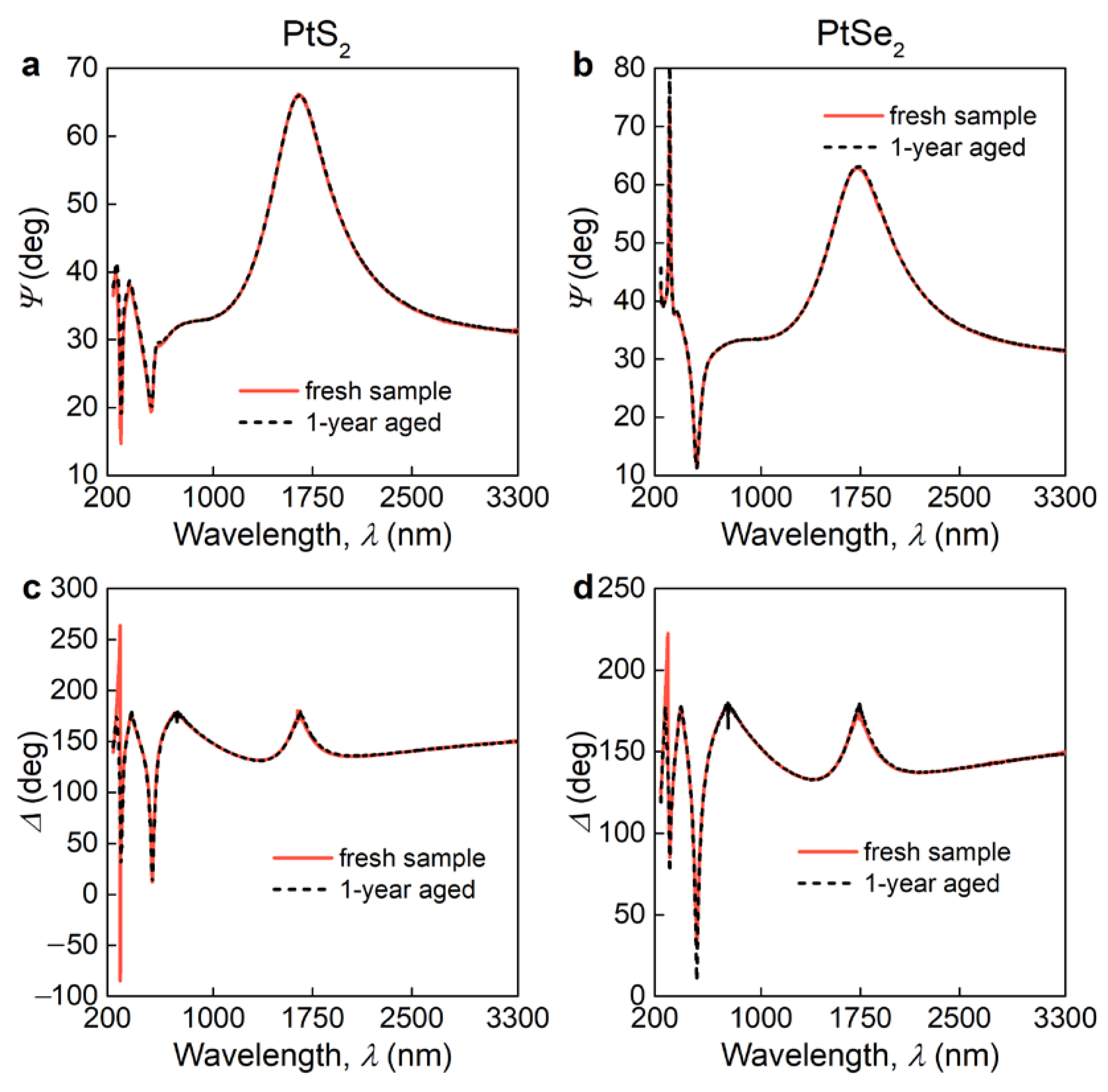
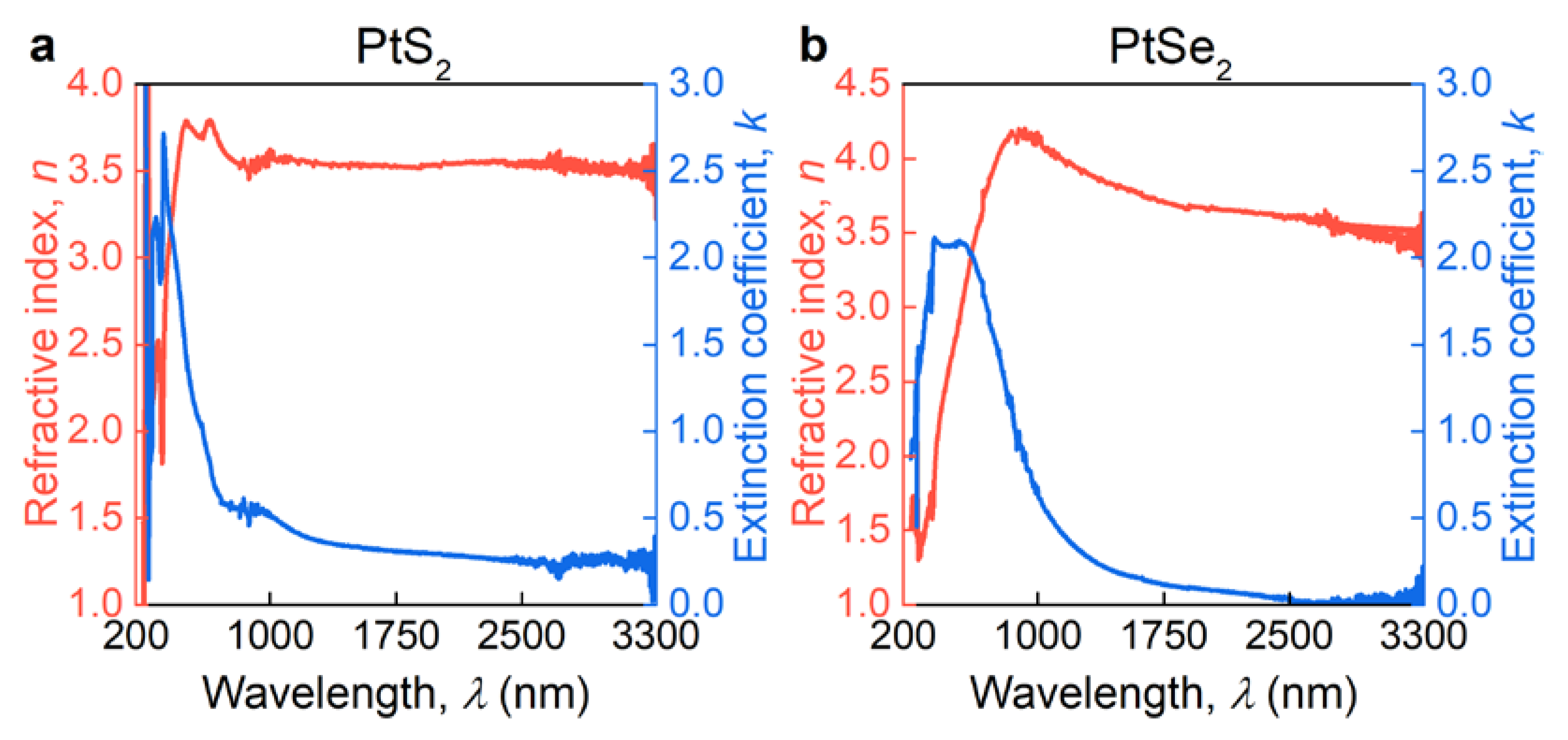
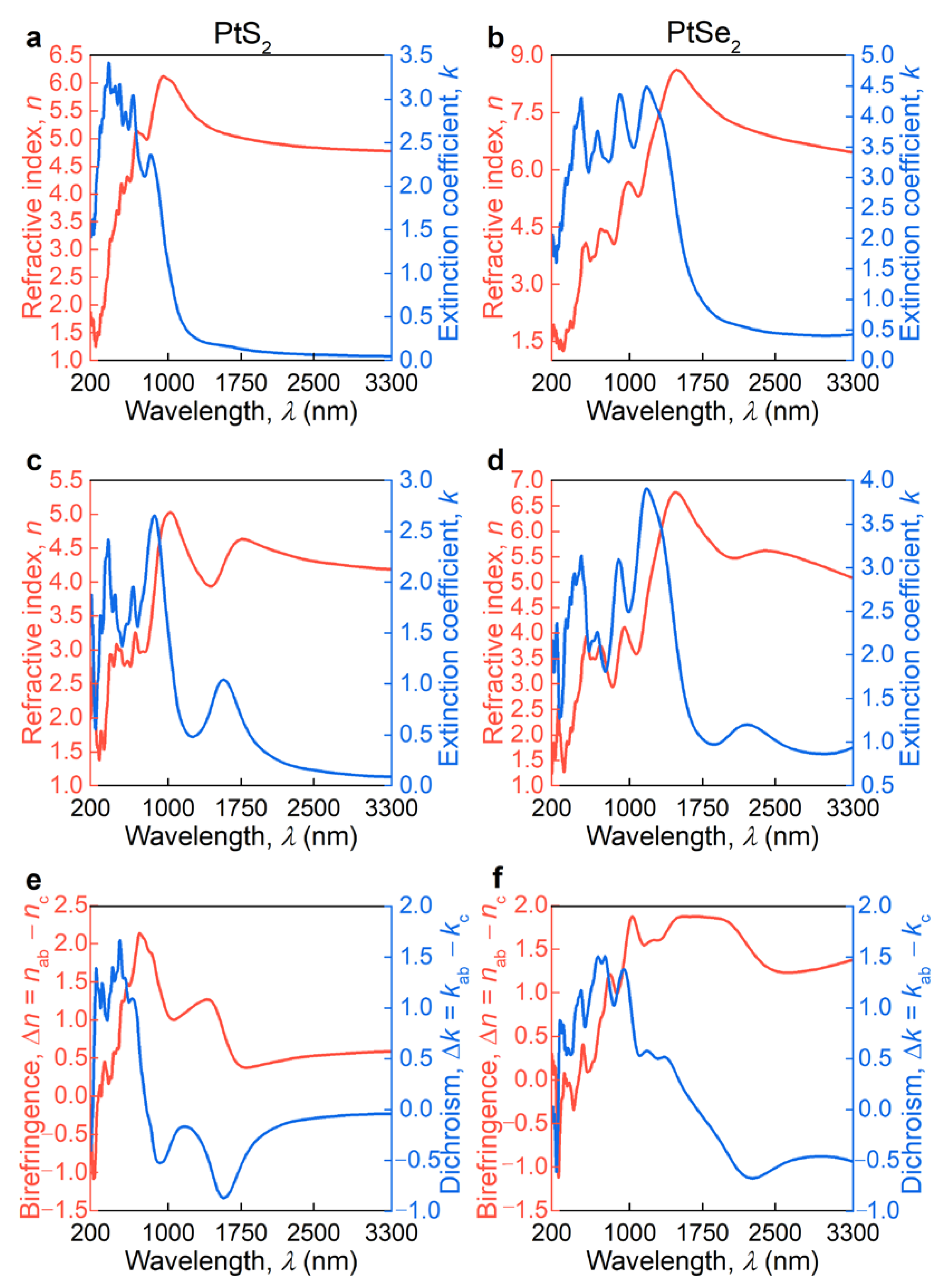
| PtS2 | PtSe2 | |||
|---|---|---|---|---|
| λ (nm) | n | k | n | k |
| 250 | 1.7037 | 2.5497 | 1.6559 | 0.8959 |
| 300 | 2.3991 | 2.0033 | 1.4828 | 1.4051 |
| 350 | 2.1384 | 2.1745 | 1.6315 | 1.8340 |
| 400 | 3.1896 | 2.2133 | 2.1016 | 2.0953 |
| 450 | 3.5743 | 1.8970 | 2.4795 | 2.0778 |
| 500 | 3.7603 | 1.4317 | 2.7416 | 2.0768 |
| 550 | 3.7307 | 1.1122 | 3.0327 | 2.0632 |
| 600 | 3.6664 | 0.9279 | 3.3009 | 1.9786 |
| 650 | 3.6139 | 0.8156 | 3.5186 | 1.8786 |
| 700 | 3.5777 | 0.7403 | 3.7384 | 1.7766 |
| 750 | 3.5543 | 0.6850 | 3.9639 | 1.6139 |
| 800 | 3.5398 | 0.6414 | 4.1262 | 1.3813 |
| 850 | 3.5313 | 0.6050 | 4.1946 | 1.1391 |
| 900 | 3.5268 | 0.5733 | 4.1961 | 0.9328 |
| 1200 | 3.5306 | 0.4338 | 3.9555 | 0.3629 |
| 1500 | 3.5400 | 0.3387 | 3.7989 | 0.1871 |
| 1800 | 3.5437 | 0.2693 | 3.7062 | 0.1050 |
| 2100 | 3.5430 | 0.2171 | 3.6446 | 0.0593 |
| 2400 | 3.5397 | 0.1768 | 3.6001 | 0.0319 |
| 2700 | 3.5350 | 0.1450 | 3.5663 | 0.0153 |
| 3000 | 3.5296 | 0.1196 | 3.5400 | 0.0057 |
| 3300 | 3.5238 | 0.0990 | 3.5194 | 0.0011 |
References
- Thakar, K.; Lodha, S. Optoelectronic and photonic devices based on transition metal dichalcogenides. Mater. Res. Express 2020, 7, 014002. [Google Scholar] [CrossRef]
- Manzeli, S.; Ovchinnikov, D.; Pasquier, D.; Yazyev, O.V.; Kis, A. 2D transition metal dichalcogenides. Nat. Rev. Mater. 2017, 2, 17033. [Google Scholar] [CrossRef]
- Pi, L.; Li, L.; Liu, K.; Zhang, Q.; Li, H.; Zhai, T. Recent Progress on 2D Noble-Transition-Metal Dichalcogenides. Adv. Funct. Mater. 2019, 29, 1904932. [Google Scholar] [CrossRef]
- Elahi, E.; Khan, M.F.; Rehman, S.; Khalil, H.M.W.; Rehman, M.A.; Kim, D.; Kim, H.; Khan, K.; Shahzad, M.; Iqbal, M.W.; et al. Enhanced electrical and broad spectral (UV-Vis-NIR) photodetection in a Gr/ReSe2/Gr heterojunction. Dalt. Trans. 2020, 49, 10017–10027. [Google Scholar] [CrossRef]
- Ghorai, A.; Ray, S.K.; Midya, A. MoSe2 Nanosheets with Tuneable Optical Properties for Broadband Visible Light Photodetection. ACS Appl. Nano Mater. 2021, 4, 2999–3006. [Google Scholar] [CrossRef]
- Jing, Y.; Liu, B.; Zhu, X.; Ouyang, F.; Sun, J.; Zhou, Y. Tunable electronic structure of two-dimensional transition metal chalcogenides for optoelectronic applications. Nanophotonics 2020, 9, 1675–1694. [Google Scholar] [CrossRef]
- Bao, W.; Cai, X.; Kim, D.; Sridhara, K.; Fuhrer, M.S. High mobility ambipolar MoS2 field-effect transistors: Substrate and dielectric effects. Appl. Phys. Lett. 2013, 102, 042104. [Google Scholar] [CrossRef] [Green Version]
- Ermolaev, G.A.; Grudinin, D.V.; Stebunov, Y.V.; Voronin, K.V.; Kravets, V.G.; Duan, J.; Mazitov, A.B.; Tselikov, G.I.; Bylinkin, A.; Yakubovsky, D.I.; et al. Giant optical anisotropy in transition metal dichalcogenides for next-generation photonics. Nat. Commun. 2021, 12, 854. [Google Scholar] [CrossRef]
- Ermolaev, G.A.; Stebunov, Y.V.; Vyshnevyy, A.A.; Tatarkin, D.E.; Yakubovsky, D.I.; Novikov, S.M.; Baranov, D.G.; Shegai, T.; Nikitin, A.Y.; Arsenin, A.V.; et al. Broadband optical properties of monolayer and bulk MoS2. npj 2D Mater. Appl. 2020, 4, 1–6. [Google Scholar] [CrossRef]
- Niu, Y.; Gonzalez-Abad, S.; Frisenda, R.; Marauhn, P.; Drüppel, M.; Gant, P.; Schmidt, R.; Taghavi, N.; Barcons, D.; Molina-Mendoza, A.; et al. Thickness-Dependent Differential Reflectance Spectra of Monolayer and Few-Layer MoS2, MoSe2, WS2 and WSe2. Nanomaterials 2018, 8, 725. [Google Scholar] [CrossRef] [PubMed] [Green Version]
- Carrascoso, F.; Li, H.; Frisenda, R.; Castellanos-Gomez, A. Strain engineering in single-, bi- and tri-layer MoS2, MoSe2, WS2 and WSe2. Nano Res. 2021, 14, 1698–1703. [Google Scholar] [CrossRef]
- Sajjad, M.; Singh, N.; Schwingenschlögl, U. Strongly bound excitons in monolayer PtS2 and PtSe2. Appl. Phys. Lett. 2018, 112, 043101. [Google Scholar] [CrossRef] [Green Version]
- Mueller, T.; Malic, E. Exciton physics and device application of two-dimensional transition metal dichalcogenide semiconductors. npj 2D Mater. Appl. 2018, 2, 1–12. [Google Scholar] [CrossRef] [Green Version]
- Wang, G.; Chernikov, A.; Glazov, M.M.; Heinz, T.F.; Marie, X.; Amand, T.; Urbaszek, B. Colloquium: Excitons in atomically thin transition metal dichalcogenides. Rev. Mod. Phys. 2018, 90, 021001. [Google Scholar] [CrossRef] [Green Version]
- Gao, J.; Li, B.; Tan, J.; Chow, P.; Lu, T.-M.; Koratkar, N. Aging of Transition Metal Dichalcogenide Monolayers. ACS Nano 2016, 10, 2628–2635. [Google Scholar] [CrossRef]
- Mounet, N.; Gibertini, M.; Schwaller, P.; Campi, D.; Merkys, A.; Marrazzo, A.; Sohier, T.; Castelli, I.E.; Cepellotti, A.; Pizzi, G.; et al. Two-dimensional materials from high-throughput computational exfoliation of experimentally known compounds. Nat. Nanotechnol. 2018, 13, 246–252. [Google Scholar] [CrossRef] [PubMed] [Green Version]
- Miró, P.; Ghorbani-Asl, M.; Heine, T. Two Dimensional Materials Beyond MoS2: Noble-Transition-Metal Dichalcogenides. Angew. Chemie Int. Ed. 2014, 53, 3015–3018. [Google Scholar] [CrossRef]
- Zhao, Y.; Qiao, J.; Yu, Z.; Yu, P.; Xu, K.; Lau, S.P.; Zhou, W.; Liu, Z.; Wang, X.; Ji, W.; et al. High-Electron-Mobility and Air-Stable 2D Layered PtSe2 FETs. Adv. Mater. 2017, 29, 1604230. [Google Scholar] [CrossRef]
- Oyedele, A.D.; Yang, S.; Liang, L.; Puretzky, A.A.; Wang, K.; Zhang, J.; Yu, P.; Pudasaini, P.R.; Ghosh, A.W.; Liu, Z.; et al. PdSe2: Pentagonal Two-Dimensional Layers with High Air Stability for Electronics. J. Am. Chem. Soc. 2017, 139, 14090–14097. [Google Scholar] [CrossRef]
- Ermolaev, G.; Voronin, K.; Baranov, D.G.; Kravets, V.; Tselikov, G.; Stebunov, Y.; Yakubovsky, D.; Novikov, S.; Vyshnevyy, A.; Mazitov, A.; et al. Topological phase singularities in atomically thin high-refractive-index materials. arXiv 2021, arXiv:2106.12390. [Google Scholar]
- Yu, X.; Yu, P.; Wu, D.; Singh, B.; Zeng, Q.; Lin, H.; Zhou, W.; Lin, J.; Suenaga, K.; Liu, Z.; et al. Atomically thin noble metal dichalcogenide: A broadband mid-infrared semiconductor. Nat. Commun. 2018, 9, 1545. [Google Scholar] [CrossRef]
- Yuan, J.; Mu, H.; Li, L.; Chen, Y.; Yu, W.; Zhang, K.; Sun, B.; Lin, S.; Li, S.; Bao, Q. Few-Layer Platinum Diselenide as a New Saturable Absorber for Ultrafast Fiber Lasers. ACS Appl. Mater. Interfaces 2018, 10, 21534–21540. [Google Scholar] [CrossRef] [PubMed]
- Han, S.S.; Kim, J.H.; Noh, C.; Kim, J.H.; Ji, E.; Kwon, J.; Yu, S.M.; Ko, T.-J.; Okogbue, E.; Oh, K.H.; et al. Horizontal-to-Vertical Transition of 2D Layer Orientation in Low-Temperature Chemical Vapor Deposition-Grown PtSe 2 and Its Influences on Electrical Properties and Device Applications. ACS Appl. Mater. Interfaces 2019, 11, 13598–13607. [Google Scholar] [CrossRef]
- Jia, Y.; Li, Z.; Wang, H.; Saeed, M.; Cai, H. Sensitivity Enhancement of a Surface Plasmon Resonance Sensor with Platinum Diselenide. Sensors 2019, 20, 131. [Google Scholar] [CrossRef] [Green Version]
- Wang, Y.; Deng, Z.-L.; Hu, D.; Yuan, J.; Ou, Q.; Qin, F.; Zhang, Y.; Ouyang, X.; Li, Y.; Peng, B.; et al. Atomically Thin Noble Metal Dichalcogenides for Phase-Regulated Meta-optics. Nano Lett. 2020, 20, 7811–7818. [Google Scholar] [CrossRef]
- Lin, H.; Xu, Z.-Q.; Cao, G.; Zhang, Y.; Zhou, J.; Wang, Z.; Wan, Z.; Liu, Z.; Loh, K.P.; Qiu, C.-W.; et al. Diffraction-limited imaging with monolayer 2D material-based ultrathin flat lenses. Light Sci. Appl. 2020, 9, 137. [Google Scholar] [CrossRef]
- O’Brien, M.; McEvoy, N.; Motta, C.; Zheng, J.-Y.; Berner, N.C.; Kotakoski, J.; Elibol, K.; Pennycook, T.J.; Meyer, J.C.; Yim, C.; et al. Raman characterization of platinum diselenide thin films. 2D Mater. 2016, 3, 021004. [Google Scholar] [CrossRef] [Green Version]
- Cullen, C.P.; Ó Coileáin, C.; McManus, J.B.; Hartwig, O.; McCloskey, D.; Duesberg, G.S.; McEvoy, N. Synthesis and characterisation of thin-film platinum disulfide and platinum sulfide. Nanoscale 2021, 13, 7403–7411. [Google Scholar] [CrossRef] [PubMed]
- Zhao, X.; Liu, F.; Liu, D.; Yan, X.-Q.; Huo, C.; Hui, W.; Xie, J.; Ye, Q.; Guo, C.; Yao, Y.; et al. Thickness-dependent ultrafast nonlinear absorption properties of PtSe2 films with both semiconducting and semimetallic phases. Appl. Phys. Lett. 2019, 115, 263102. [Google Scholar] [CrossRef]
- Lu, J.; Zhang, X.; Su, G.; Yang, W.; Han, K.; Yu, X.; Wan, Y.; Wang, X.; Yang, P. Large-area uniform few-layer PtS2: Synthesis, structure and physical properties. Mater. Today Phys. 2021, 18, 100376. [Google Scholar] [CrossRef]
- Grillo, A.; Faella, E.; Pelella, A.; Giubileo, F.; Ansari, L.; Gity, F.; Hurley, P.K.; McEvoy, N.; Di Bartolomeo, A. Coexistence of Negative and Positive Photoconductivity in Few-Layer PtSe2 Field-Effect Transistors. Adv. Funct. Mater. 2021, 31, 2105722. [Google Scholar] [CrossRef]
- Xie, J.; Zhang, D.; Yan, X.-Q.; Ren, M.; Zhao, X.; Liu, F.; Sun, R.; Li, X.; Li, Z.; Chen, S.; et al. Optical properties of chemical vapor deposition-grown PtSe2 characterized by spectroscopic ellipsometry. 2D Mater. 2019, 6, 035011. [Google Scholar] [CrossRef]
- Gulo, D.P.; Yeh, H.; Chang, W.-H.; Liu, H.-L. Temperature-dependent optical and vibrational properties of PtSe2 thin films. Sci. Rep. 2020, 10, 19003. [Google Scholar] [CrossRef] [PubMed]
- He, J.; Jiang, W.; Zhu, X.; Zhang, R.; Wang, J.; Zhu, M.; Wang, S.; Zheng, Y.; Chen, L. Optical properties of thickness-controlled PtSe2 thin films studied via spectroscopic ellipsometry. Phys. Chem. Chem. Phys. 2020, 22, 26383–26389. [Google Scholar] [CrossRef]
- Khmelevskaia, D.; Markina, D.I.; Fedorov, V.V.; Ermolaev, G.A.; Arsenin, A.V.; Volkov, V.S.; Goltaev, A.S.; Zadiranov, Y.M.; Tzibizov, I.A.; Pushkarev, A.P.; et al. Directly grown crystalline gallium phosphide on sapphire for nonlinear all-dielectric nanophotonics. Appl. Phys. Lett. 2021, 118, 201101. [Google Scholar] [CrossRef]
- Evlyukhin, A.B.; Novikov, S.M.; Zywietz, U.; Eriksen, R.L.; Reinhardt, C.; Bozhevolnyi, S.I.; Chichkov, B.N. Demonstration of Magnetic Dipole Resonances of Dielectric Nanospheres in the Visible Region. Nano Lett. 2012, 12, 3749–3755. [Google Scholar] [CrossRef]
- Baranov, D.G.; Zuev, D.A.; Lepeshov, S.I.; Kotov, O.V.; Krasnok, A.E.; Evlyukhin, A.B.; Chichkov, B.N. All-dielectric nanophotonics: The quest for better materials and fabrication techniques. Optica 2017, 4, 814. [Google Scholar] [CrossRef]
- Perdew, J.P.; Burke, K.; Ernzerhof, M. Generalized gradient approximation made simple. Phys. Rev. Lett. 1996, 77, 3865–3868. [Google Scholar] [CrossRef] [Green Version]
- Kresse, G.; Joubert, D. From ultrasoft pseudopotentials to the projector augmented-wave method. Phys. Rev. B 1999, 59, 1758–1775. [Google Scholar] [CrossRef]
- Thomassen, L. Ueber Kristallstrukturen einiger binaerer Verbindungen der Platinmetalle. Z. Fuer Phys. Chem. Abt. B Chem. Der Elem. Aufbau Der Mater. 1929, 2, 349–379. [Google Scholar]
- Shishkin, M.; Kresse, G. Implementation and performance of the frequency-dependent GW method within the PAW framework. Phys. Rev. B-Condens. Matter Mater. Phys. 2006, 74, 1–13. [Google Scholar] [CrossRef] [Green Version]
- Gurarslan, A.; Yu, Y.; Su, L.; Yu, Y.; Suarez, F.; Yao, S.; Zhu, Y.; Ozturk, M.; Zhang, Y.; Cao, L. Surface-energy-assisted perfect transfer of centimeter-scale monolayer and few-layer MoS2 films onto arbitrary substrates. ACS Nano 2014, 8, 11522–11528. [Google Scholar] [CrossRef] [PubMed]
- Gong, Y.; Lin, Z.; Chen, Y.-X.; Khan, Q.; Wang, C.; Zhang, B.; Nie, G.; Xie, N.; Li, D. Two-Dimensional Platinum Diselenide: Synthesis, Emerging Applications, and Future Challenges. Nano-Micro Lett. 2020, 12, 174. [Google Scholar] [CrossRef]
- El-Sayed, M.A.; Ermolaev, G.A.; Voronin, K.V.; Romanov, R.I.; Tselikov, G.I.; Yakubovsky, D.I.; Doroshina, N.V.; Nemtsov, A.B.; Solovey, V.R.; Voronov, A.A.; et al. Optical Constants of Chemical Vapor Deposited Graphene for Photonic Applications. Nanomaterials 2021, 11, 1230. [Google Scholar] [CrossRef]
- Harland, G.; Tompkins, J.N.H. Spectroscopic Ellipsometry Practical Application to Thin Film Characterization; Wiley: Hoboken, NJ, USA, 2016; ISBN 9780470060193. [Google Scholar]
- Ermolaev, G.A.; Yakubovsky, D.I.; Stebunov, Y.V.; Arsenin, A.V.; Volkov, V.S. Spectral ellipsometry of monolayer transition metal dichalcogenides: Analysis of excitonic peaks in dispersion. J. Vac. Sci. Technol. B 2020, 38, 014002. [Google Scholar] [CrossRef]
- Liu, H.-L.; Shen, C.-C.; Su, S.-H.; Hsu, C.-L.; Li, M.-Y.; Li, L.-J. Optical properties of monolayer transition metal dichalcogenides probed by spectroscopic ellipsometry. Appl. Phys. Lett. 2014, 105, 201905. [Google Scholar] [CrossRef] [Green Version]
- Ermolaev, G.A.; El-Sayed, M.A.; Yakubovsky, D.I.; Voronin, K.V.; Romanov, R.I.; Tatmyshevskiy, M.K.; Doroshina, N.V.; Nemtsov, A.B.; Voronov, A.A.; Novikov, S.M.; et al. Optical Constants and Structural Properties of Epitaxial MoS2 Monolayers. Nanomaterials 2021, 11, 1411. [Google Scholar] [CrossRef] [PubMed]
- Frisenda, R.; Niu, Y.; Gant, P.; Molina-Mendoza, A.J.; Schmidt, R.; Bratschitsch, R.; Liu, J.; Fu, L.; Dumcenco, D.; Kis, A.; et al. Micro-reflectance and transmittance spectroscopy: A versatile and powerful tool to characterize 2D materials. J. Phys. D. Appl. Phys. 2017, 50, 074002. [Google Scholar] [CrossRef]
- Passler, N.C.; Paarmann, A. Generalized 4 × 4 matrix formalism for light propagation in anisotropic stratified media: Study of surface phonon polaritons in polar dielectric heterostructures. J. Opt. Soc. Am. B 2017, 34, 2128. [Google Scholar] [CrossRef] [Green Version]
- Blake, P.; Hill, E.W.; Castro Neto, A.H.; Novoselov, K.S.; Jiang, D.; Yang, R.; Booth, T.J.; Geim, A.K. Making graphene visible. Appl. Phys. Lett. 2007, 91, 063124. [Google Scholar] [CrossRef] [Green Version]
- Kretschmann, E.; Raether, H. Notizen: Radiative Decay of Non Radiative Surface Plasmons Excited by Light. Zeitschrift Für Naturforsch. A 1968, 23, 2135–2136. [Google Scholar] [CrossRef]
- Stebunov, Y.V.; Yakubovsky, D.I.; Fedyanin, D.Y.; Arsenin, A.V.; Volkov, V.S. Superior Sensitivity of Copper-Based Plasmonic Biosensors. Langmuir 2018, 34, 4681–4687. [Google Scholar] [CrossRef] [PubMed] [Green Version]
- Stebunov, Y.V.; Aftenieva, O.A.; Arsenin, A.V.; Volkov, V.S. Highly Sensitive and Selective Sensor Chips with Graphene-Oxide Linking Layer. ACS Appl. Mater. Interfaces 2015, 7, 21727–21734. [Google Scholar] [CrossRef] [PubMed]
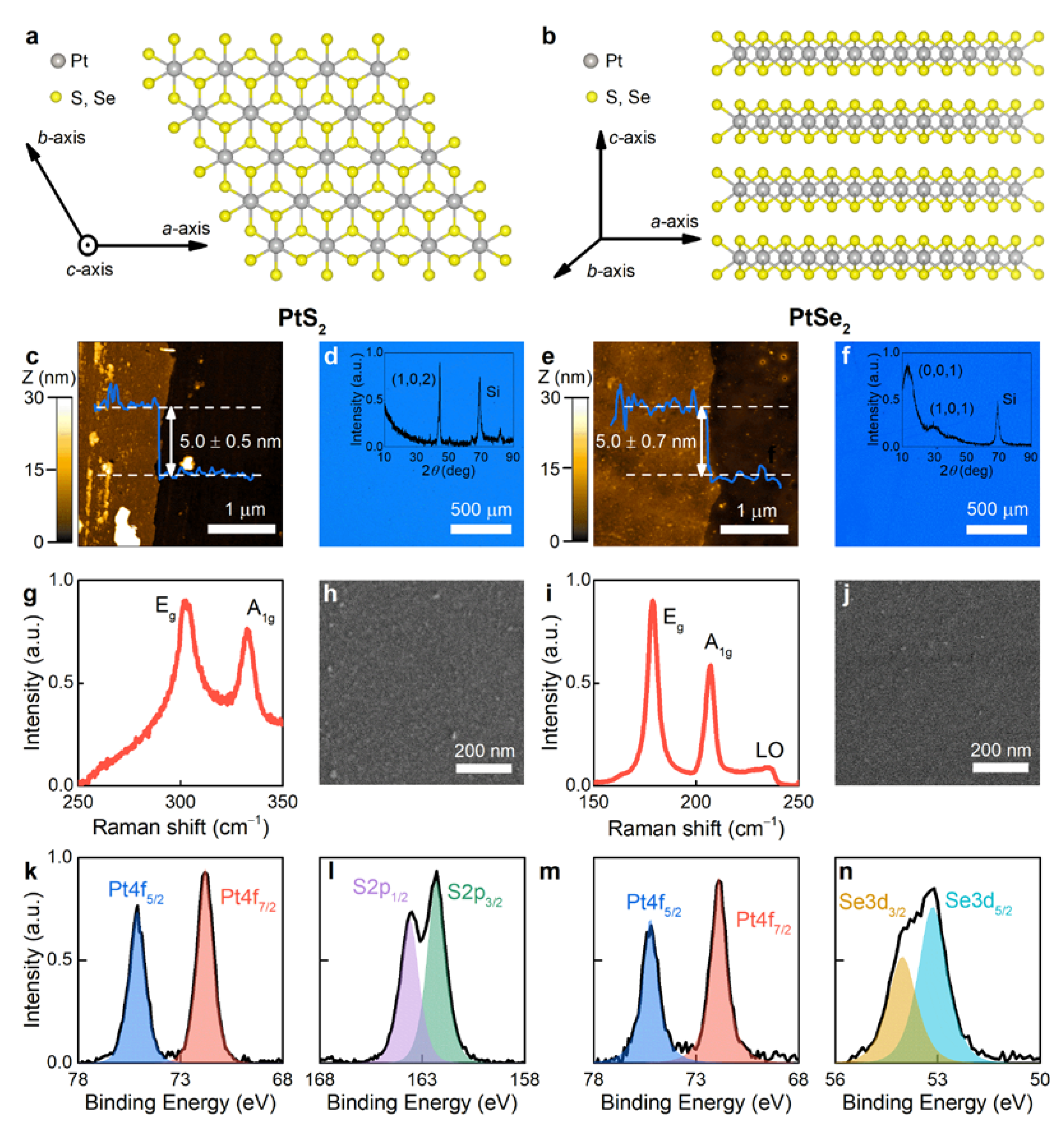
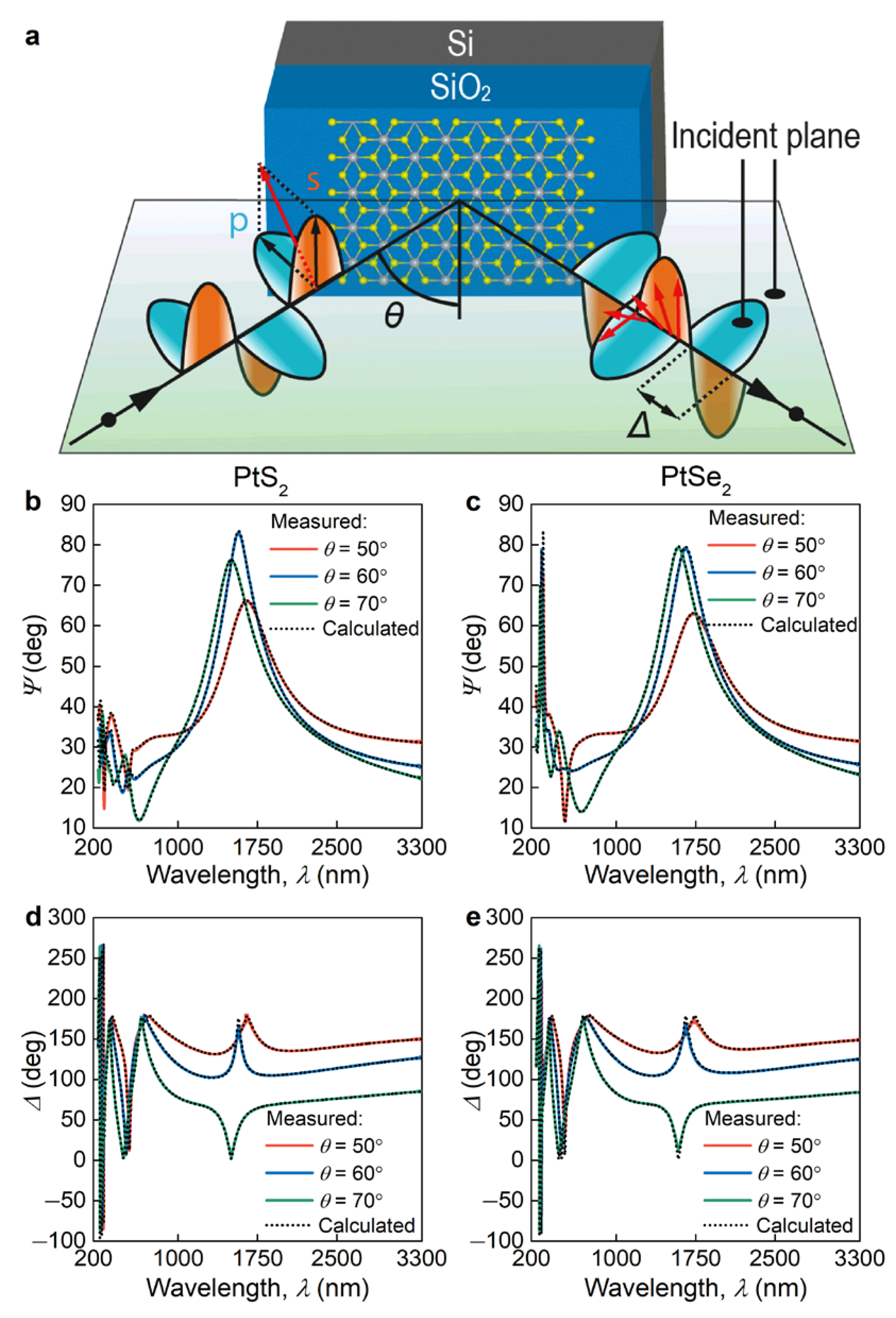
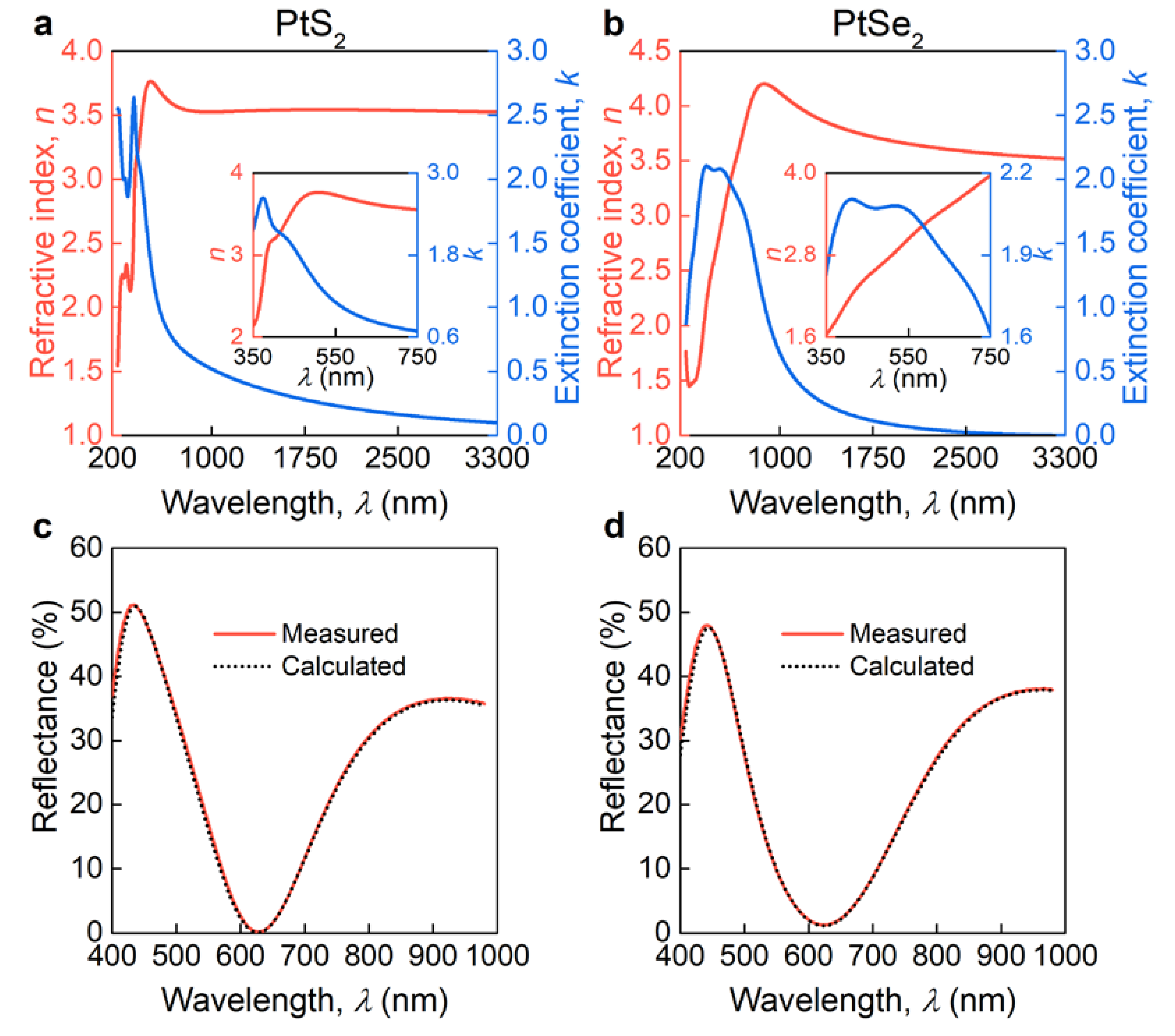
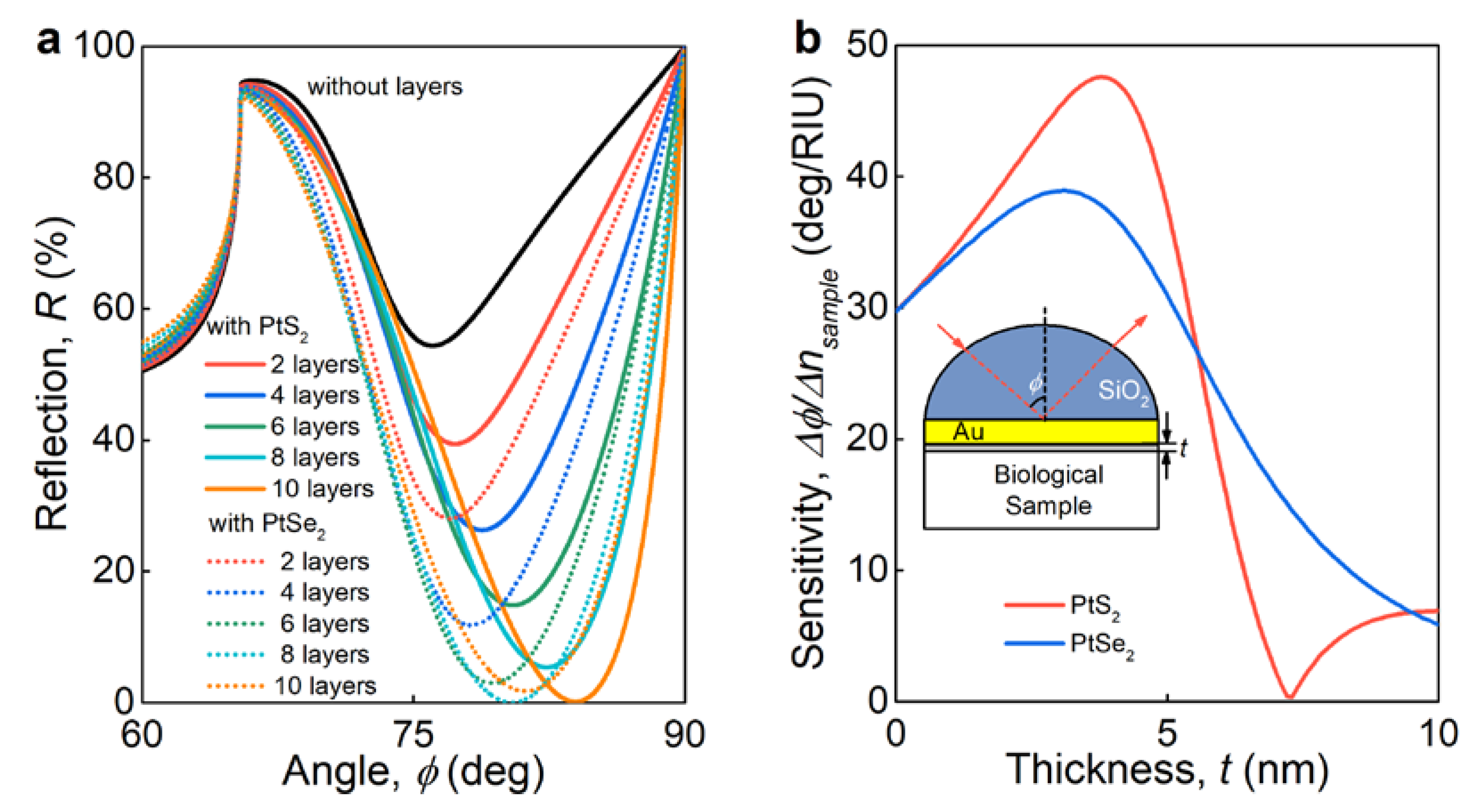
| Oscillator | A (eV) | C (eV) | E0 (eV) |
|---|---|---|---|
| #1 | 13.177 | 6.154 | 2.595 |
| #2 | 13.274 | 1.183 | 2.879 |
| #3 | 1.879 | 0.328 | 3.268 |
| #4 | 0.905 | 0.440 | 4.000 |
| #5 | 11.197 | 1.338 | 4.759 |
| Oscillator | A (eV) | C (eV) | E0 (eV) |
|---|---|---|---|
| #1 | 8.177 | 0.734 | 1.654 |
| #2 | 14.917 | 1.307 | 2.200 |
| #3 | 10.018 | 1.469 | 3.049 |
| #4 | 2.325 | 1.399 | 4.359 |
| #5 | 6.608 | 0.530 | 5.782 |
Publisher’s Note: MDPI stays neutral with regard to jurisdictional claims in published maps and institutional affiliations. |
© 2021 by the authors. Licensee MDPI, Basel, Switzerland. This article is an open access article distributed under the terms and conditions of the Creative Commons Attribution (CC BY) license (https://creativecommons.org/licenses/by/4.0/).
Share and Cite
Ermolaev, G.A.; Voronin, K.V.; Tatmyshevskiy, M.K.; Mazitov, A.B.; Slavich, A.S.; Yakubovsky, D.I.; Tselin, A.P.; Mironov, M.S.; Romanov, R.I.; Markeev, A.M.; et al. Broadband Optical Properties of Atomically Thin PtS2 and PtSe2. Nanomaterials 2021, 11, 3269. https://doi.org/10.3390/nano11123269
Ermolaev GA, Voronin KV, Tatmyshevskiy MK, Mazitov AB, Slavich AS, Yakubovsky DI, Tselin AP, Mironov MS, Romanov RI, Markeev AM, et al. Broadband Optical Properties of Atomically Thin PtS2 and PtSe2. Nanomaterials. 2021; 11(12):3269. https://doi.org/10.3390/nano11123269
Chicago/Turabian StyleErmolaev, Georgy A., Kirill V. Voronin, Mikhail K. Tatmyshevskiy, Arslan B. Mazitov, Aleksandr S. Slavich, Dmitry I. Yakubovsky, Andrey P. Tselin, Mikhail S. Mironov, Roman I. Romanov, Andrey M. Markeev, and et al. 2021. "Broadband Optical Properties of Atomically Thin PtS2 and PtSe2" Nanomaterials 11, no. 12: 3269. https://doi.org/10.3390/nano11123269
APA StyleErmolaev, G. A., Voronin, K. V., Tatmyshevskiy, M. K., Mazitov, A. B., Slavich, A. S., Yakubovsky, D. I., Tselin, A. P., Mironov, M. S., Romanov, R. I., Markeev, A. M., Kruglov, I. A., Novikov, S. M., Vyshnevyy, A. A., Arsenin, A. V., & Volkov, V. S. (2021). Broadband Optical Properties of Atomically Thin PtS2 and PtSe2. Nanomaterials, 11(12), 3269. https://doi.org/10.3390/nano11123269








